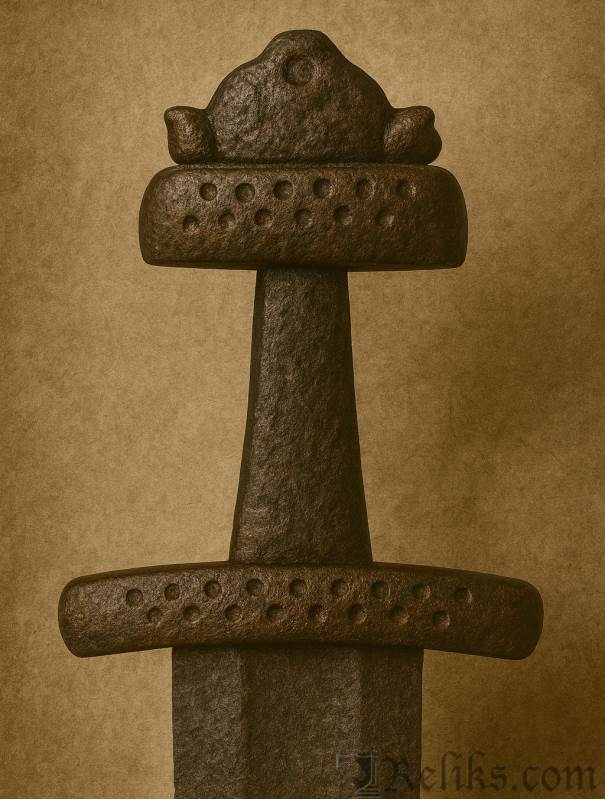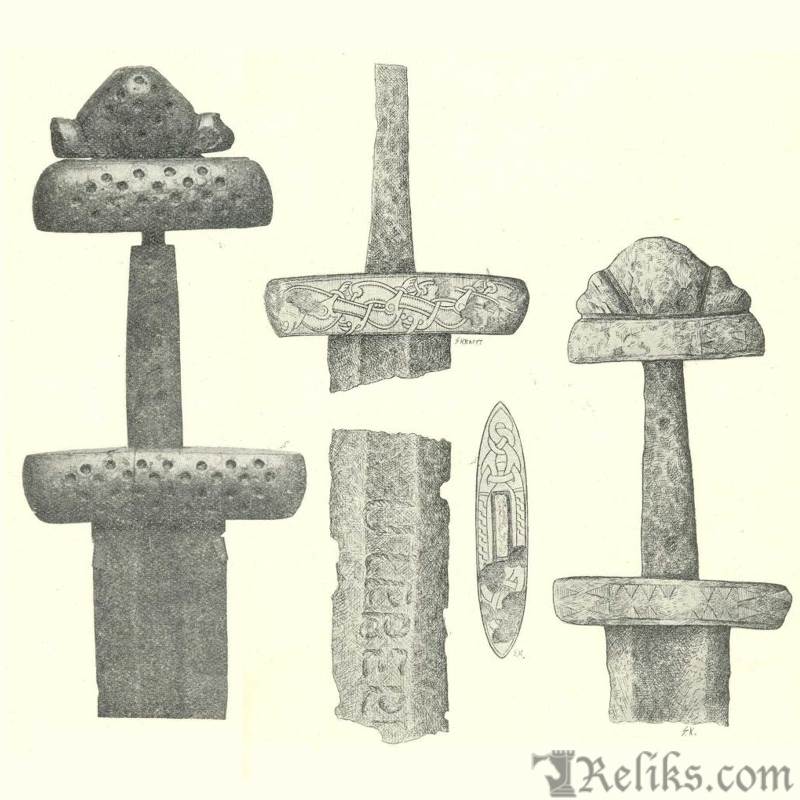Viking Sword Type T (Late 10th Century)
Overview
Type T continues the line of richly mounted hilts that began with Types R and S, but it does so in a slightly more restrained way. The pommel remains a thickened, tripartite block, with side lobes that often echo the shape of animal heads. Yet unlike Type S, the guards do not flare both upward and downward at the ends. Instead, they remain straight or only gently bowed, tapering at the ends so that the upper guard tips rise slightly and the lower guard tips slope down. This gives the whole hilt a taut, almost compact profile.
Despite its relative rarity, the type is of great interest because it combines ornament of high quality with inscriptions like ULFBERHT and REX, showing that continental blade traditions continued to filter north deep into the 10th century.
Form & Ornament

Viking Sword Type T (Late 10th Century)
The hilt of Type T is even in height, not swollen at the center like the earlier heavy styles. Guards are plain in outline but inturned at the tips, upper guard upward, lower guard downward. The pommel, divided into three sections, often shows its heritage most clearly: the side lobes carry the snout-and-eye suggestion of stylized beast heads
.
Two ornament traditions appear:
- Hedmark group (C 3210, C 3867, C 9530, C 11318): richly silver-plated, decorated with concentric circles hammered around drilled recesses. One specimen (C 3867) carries zoomorphic interlace in Insular (Irish) style, according to Sophus Müller. Another (C 11318) hints at mouth and eyes on the side lobes, paralleling an English Thames find.
- Telemark group (C 1648, C 17958): ornamented instead with striped triangular and rectangular silver bands, arranged in orderly geometric patterns.
All recorded examples are double-edged. Two carry famous inscriptions: ULFBERHT (C 3867, Østre Alm, Stange) and REX (C 1648, Utgaarden, Seljord).
Distribution & Numbers
Petersen knew only six true specimens in Norway: four from Hedmarken and two from Telemark. This concentration is unusual: Hedmark in particular seems to have been a hotbed for this sub-style, while the Telemark pieces look slightly different, perhaps reflecting regional workshops or outside influence.
Beyond Norway, related hilts with similar silver-strip ornament are noted in Russia (Ascheraden in Courland) and Sweden (Uppland, Gästrikland), though often on variant sword types. This suggests that T was not widespread but instead part of a select, prestige current of the later Viking Age.
Finds in Context & Dating
Associated grave goods anchor the type firmly in the later 10th century, with some overlap into the 11th:
- C 3867 (Stange): with an L-type axe, a slender spear with multiple rivets, two R 565 shield bosses, late stirrups, and even a gaming piece of the youngest form—all hallmarks of the 10th-century close.
- Other Hedmark examples pair with M- and K-type axes, again late weapons, and more R 565 bosses.
- Telemark (C 1648): found with three young rattle types (rangles), another late clue.
Taken together, the evidence places Type T in the final decades of the Viking Age—late 10th into early 11th century. The inscriptions raise puzzles: Ulfberht is usually tied to the early 10th, yet here appears on a clearly late hilt. The simplest explanation is that older Frankish blades were rehilted in Norway, or that the ULFBERHT stamp remained in use longer than once believed.
Origins & Influence

Petersen(fig.119-121)
Like R and S, Type T was not a native invention. The ULFBERHT and REX blades point straight to the Frankish world, while the Insular-style ornament on C 3867 hints at Irish influence carried east. The Telemark group’s geometric silver inlays share parallels with finds from Russia and Sweden, suggesting a broader northern reception of continental decorative fashions.
Still, the Hedmark concentration raises the possibility of local workshops adapting imported ideas into a distinctive sub-style. In this sense, Type T may represent the last wave of continental prestige hilts, localized in Norway at the twilight of the Viking Age.
Why Type T Matters
Type T is a fascinating capstone: late in date, rich in ornament, and tied to inscriptions that span the entire Viking Age. It demonstrates how prestige blades could live long lives, being refitted with new hilts generations after forging, and how ornamentic styles shifted from animal heads to geometric silver inlay. For collectors and historians, T is proof that the Viking sword typology remained dynamic right up to the dawn of the medieval knightly sword.
Core classification based on Jan Petersen, De Norske Vikingesverd (1919). Additional commentary by Reliks.com.